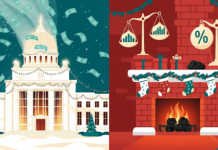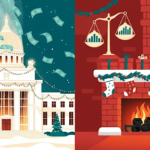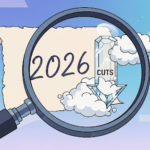Tariff Trouble in Disguise
Markets have been in a curious mood lately. Investors seem far more concerned about what the Federal Reserve might do next than about whether tariffs could quietly sabotage the economic recovery. The latest BofA Global survey shows trade policy anxiety fading into the background, thanks in part to a summer of “skinny” trade deals that gave the impression the worst was behind us. Yet beneath the calm surface, there are clear signals that tariff fatigue could be a costly blind spot.
While over half of imports still enter the U.S. duty-free, the effective tariff rate is already near 10% and may rise to 15% in the coming quarter. That’s not just a headline figure—it represents a slow tightening on business costs and consumer prices, a kind of stealth economic pressure. Barclays warns that if exemptions close or trade diversions are curtailed, the real economic drag could hit harder than markets expect.
Meanwhile, the Fed’s next move is still top of mind for traders, especially after softer jobs data increased bets on a September rate cut. But in the rush to cheer potential lower rates, investors might be overlooking the fact that tariffs and their inflationary impact could tie the Fed’s hands just when the economy needs support.
Today’s Market Pulse dives into why tariffs still matter, even when markets pretend they don’t, what history tells us about trade complacency, and a little humor in The Fun Corner. Plus, in This Week I Learned, we’ll uncover how “effective tariffs” are often lower than the ones making headlines—but that might not be good news for long.
This Week I Learned…
The Tariff Mirage
This week I learned about why effective tariff rates don’t always match the headlines. The U.S. has announced billions in tariff measures over the past year, but according to Barclays research, over half of imports still arrive without paying a dime in duties. This is due to a mix of trade diversions, product-specific exemptions, and creative reclassifications.
It’s like reading a price tag that says $100 but realizing at checkout that the store is only charging $50, except in this case, the store (the U.S. government) is fine with collecting less for now. The current effective tariff rate sits at around 10%, well below the public perception of a harsher trade clampdown.
This gap between perception and reality has lulled many investors into a sense of security. Yet that could flip quickly. If exemptions are withdrawn or loopholes closed, the baseline tariff rate could climb toward 15% in the next quarter, creating a sudden inflationary pulse. That could catch markets off guard and force a shift in strategy just as rate cuts were expected to provide relief.
Understanding the difference between announced tariffs and effective tariffs is crucial. The former makes headlines, the latter impacts real business costs. If you’re building market expectations solely on the announced figure, you might be missing the true measure of the risk.
The Fun Corner
The Toll Booth That Wasn’t There
They say tariffs are like toll booths for trade. You pay to pass, but the road stays the same. Lately, though, it’s as if half the toll booths are unmanned, letting shipments roll through without paying. No wonder investors are relaxed.
Here’s a fun market trivia: the U.S. has collected about $108 billion in tariffs this year, but that’s with an effective rate of just 10%. Imagine the revenue if every toll booth were staffed. On the flip side, imagine the traffic jam in global supply chains if that happened.
In other words, tariffs are the only toll where collecting more might actually slow the whole highway. Investors might chuckle now, but history shows these economic “toll hikes” rarely arrive with advance notice.
Why Tariff Complacency Could Cost Investors
Investors are laser-focused on the Federal Reserve’s next move, particularly after July’s weak jobs report and subsequent market rally on hopes of a September rate cut. Yet while attention is fixed on interest rates, trade policy risks are quietly building.
The latest BofA Global survey reveals that tariffs have slipped far down the worry list, replaced by concerns over economic data and Fed leadership. This shift in sentiment comes after a summer of “skinny” trade deals that reduced immediate tension but didn’t resolve the underlying uncertainty.
Barclays research highlights a key point: despite $108 billion in tariff collections so far this year, over half of imports still enter the U.S. without duties. The resulting effective tariff rate is only around 10%, cushioning the immediate impact on inflation and growth. This has likely encouraged a “buy the dip” mentality since April’s tariff shocks.
However, the benign effect may be temporary. Barclays projects that the baseline tariff rate could rise to 15% in the third quarter, especially if exemptions are rolled back or trade diversions blocked. That shift could tighten cost pressures across industries and complicate the Fed’s ability to cut rates without reigniting inflation.
Compounding the risk, stagflation concerns are back in the conversation. While unemployment remains low at 4.2%, the labor market is showing early signs of strain. St. Louis Fed President Alberto Musalem warned that tariffs could lead to persistent upward pressure on prices while weakening employment over time.
Tariffs are not yesterday’s problem, but tomorrow’s potential shock. Investors ignoring this could find themselves unprepared when the trade toll booths finally close.
The Last Say
The Cost of Looking the Other Way
Markets have a habit of focusing on the most immediate headline, and right now, that’s the Fed’s next policy move. Yet this week’s data reminds us that other forces, like tariffs, can quietly shape the market landscape. The past few months have offered an artificial sense of calm, helped by exemptions and trade diversions that kept the effective tariff rate lower than expected.
But as Barclays warns, this calm may not last. The effective rate could climb to 15% in the coming months, potentially increasing costs for businesses and consumers. That would make the Fed’s balancing act between supporting growth and controlling inflation even more delicate.
The danger lies in underestimating the cumulative effect of these policies. Tariff-induced cost pressures don’t always cause an immediate market reaction, but they can steadily erode growth and earnings potential. With the job market slowing down, there is a real risk of stagflation. This means we could see slow economic growth along with ongoing inflation.
In investing, the threats you ignore often matter more than the ones you track obsessively. Today’s market optimism may be justified in the short term, but resilience comes from preparing for risks that aren’t in the spotlight yet. Tariffs belong high on that list.






















